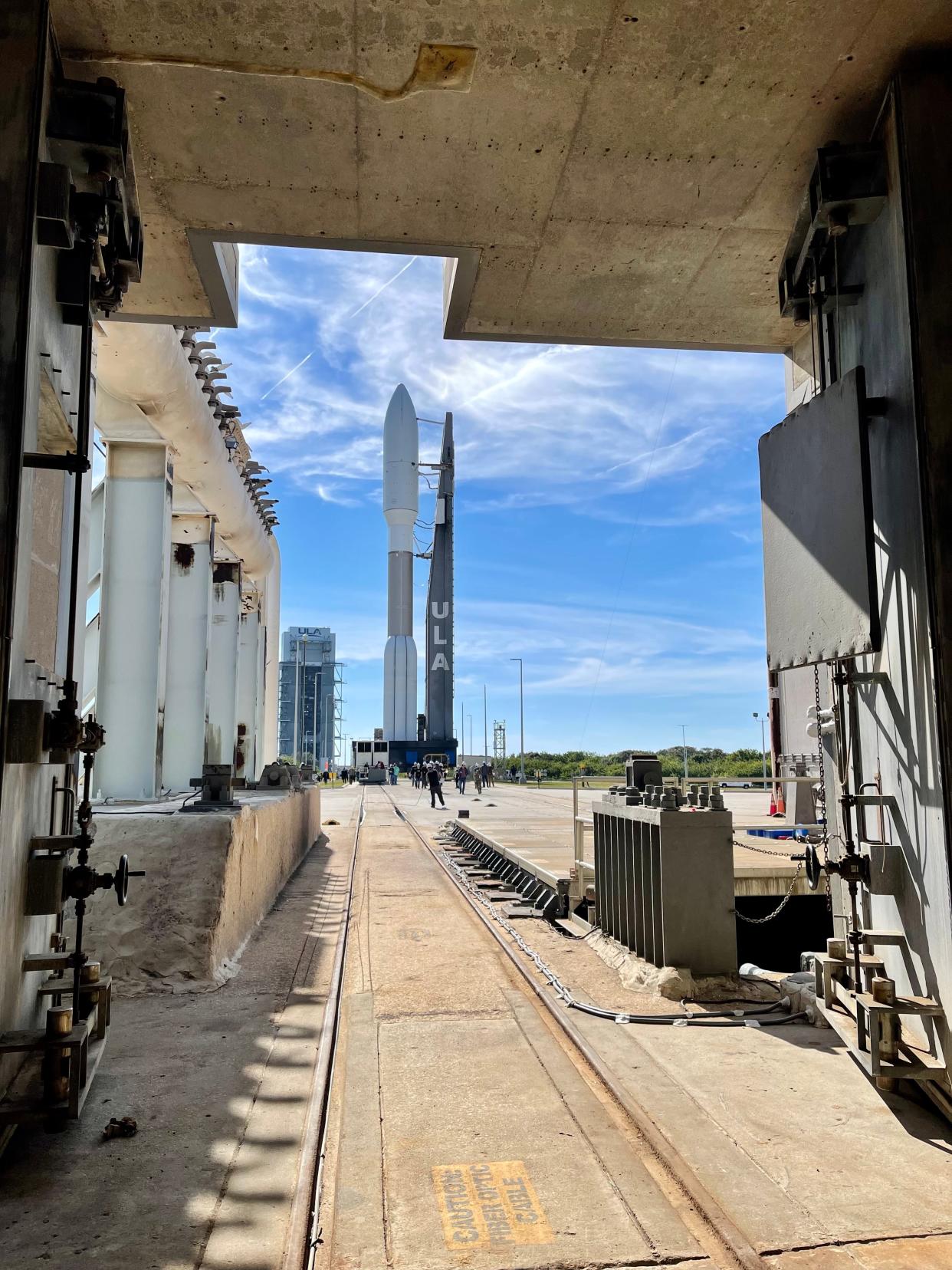Powerful ULA Atlas V rocket rolls to pad ahead of Space Force launch this weekend

Space is important to us and that’s why we're working to bring you top coverage of the industry and Florida launches. Journalism like this takes time and resources. Please support it with a subscription here.
---
Update (3:30 p.m. ET Dec. 5): United Launch Alliance again delayed this launch as teams work the propellant system issue at Launch Complex 41. Liftoff is now set for no earlier than 4:04 a.m. Tuesday, Dec. 7.
---
Update (7:15 p.m. ET Dec. 4): United Launch Alliance has delayed this mission to no earlier than 4:04 a.m. ET Monday, Dec. 6, due to a leak discovered in the propellant storage system at Launch Complex 41. Teams will have a two-hour window to launch.
---
A nearly 200-foot Atlas V rocket rolled to its pad at Cape Canaveral Space Force Station Friday afternoon, putting the most powerful configuration of the vehicle on course for launch this weekend.
Five add-on solid rocket boosters gleamed in the afternoon sunlight as United Launch Alliance teams guided the rocket over its third-of-a-mile trek from Launch Complex 41's Vertical Integration Facility to the pad. At liftoff, currently set for a two-hour window that opens at 4:04 a.m. Sunday, Atlas V's RD-180 main engine and five SRBs will produce nearly 2.4 million pounds of thrust to vault off the pad.
Space Force weather forecasters on Friday said conditions for liftoff should be excellent at 90% "go." The less-than-likely possibility of cumulus clouds forming around LC-41 was noted as the only concern.
Temperatures at the time of liftoff, meanwhile, should be a bit warmer than other mornings this week: 65 to 67 degrees.
Packed into Atlas V's payload fairing will be the Space Force's Space Test Program-3 mission, or STP-3, which features payloads from several organizations. The main payload, STPSat-6, is essentially operating as the platform to carry the following hardware:
More: Here’s what it takes to transport an NOAA satellite to from Colorado to Florida
The National Nuclear Security Administration's Space and Atmospheric Burst Reporting System-3, or SBARS-3. The roughly one-foot-wide payload developed by the Los Alamos National Laboratory will help with the detection of nuclear detonations.
NASA's Laser Communications Relay Demonstration (LCRD) experiment, which will test the ability to transmit data via lasers. Laser-based communications systems are able to handle more data than traditional radio-based options.
Several additional payloads owned by the Department of Defense will also provide insights into space weather, such as solar flares, and situational awareness, according to ULA.
Compared to more "routine" launches, Sunday's STP-3 mission is already unique thanks to the variety of payloads. But how they get to geosynchronous orbit some 22,200 miles above the equator – and how long it takes to get there – will also be quite different.
"This is a highly complex orbital insertion that requires three Centaur (upper stage) burns and precise navigation, a capability unique to the Atlas V," Gary Wentz, ULA's vice president of government and commercial programs, said in a Thursday statement. "This is our longest mission to date at seven hours and 10 minutes until final spacecraft separation."
Spectators heading outside to watch Atlas V should note the trajectory for Sunday's mission is a bit different – after liftoff, the rocket will fly straight out toward the east rather than what's usually a northeastern trajectory. The crisp, cool morning air should make for above average visibility, too.
For the latest, visit floridatoday.com/launchschedule.
Contact Emre Kelly at aekelly@floridatoday.com or 321-242-3715. Follow him on Twitter, Facebook and Instagram at @EmreKelly.
Launch Sunday, Dec. 5
Rocket: United Launch Alliance Atlas V
Configuration: 541 (5-meter fairing, 5 solid rocket boosters, 1 upper stage engine)
Mission: Space Force's STP-3
Launch Time: 4:04 a.m. ET
Launch Window: To 6:04 a.m. ET
Launch Complex: 41 at Cape Canaveral Space Force Station
Trajectory: East
Weather: 90% "go"
Visit floridatoday.com/space at 3 a.m. ET Sunday for real-time updates and video.
This article originally appeared on Florida Today: ULA Atlas V rocket rolls to pad ahead of Space Force launch on Sunday

